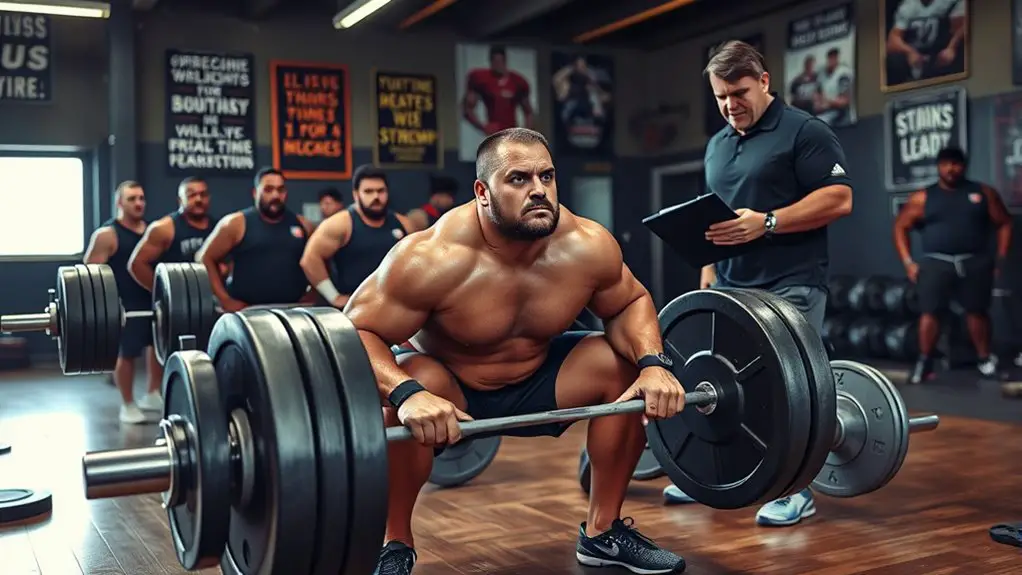To develop upper body strength for rock climbing, focus on exercises like pull-ups, chin-ups, push-ups, and shoulder presses. Engage your back, shoulders, arms, and core muscles for overall stability and power. Create a structured training plan that includes climbing-specific drills, like campus board training and traversing. Don't forget about nutrition and recovery, as they're key for muscle repair. Keep exploring training techniques, and you'll find even more ways to boost your climbing performance.
Understanding the Muscle Groups Involved in Climbing
When you think about rock climbing, it's easy to focus solely on grip strength, but understanding the muscle groups involved is essential for overall performance. Your back muscles, including the latissimus dorsi and trapezius, play a significant role in pulling your body upward. These muscles help stabilize your torso while you reach for your next hold, allowing for smooth, controlled movements.
Your shoulders, particularly the deltoids and rotator cuff muscles, are vital for maintaining range of motion and preventing injuries. The biceps and triceps contribute to your pulling and pushing actions, giving you the strength to ascend efficiently. Don't forget about your core, which stabilizes your body and enhances balance on the wall. By recognizing how these muscle groups work together, you can climb with more freedom and confidence, allowing you to explore new heights without feeling restricted. Incorporating strength training exercises into your routine can further enhance your climbing performance and help prevent injuries.
Essential Exercises for Upper Body Strength
To build upper body strength for rock climbing, incorporating a variety of targeted exercises is essential. Start with pull-ups to strengthen your lats and improve grip. You can mix things up with chin-ups to engage your biceps more. Next, try push-ups to develop your chest and triceps, enhancing your pushing power. Don't forget about shoulder presses; they'll help stabilize your shoulders during climbs.
Adding rows, whether with dumbbells or a resistance band, can also boost your back strength, which is vital for pulling yourself up. Consider incorporating plank variations to build core stability, allowing you to maintain body tension while climbing. Finally, hanging from a pull-up bar can improve your grip endurance, as grip strength is crucial for better performance in climbing.
Developing a Structured Training Plan
Creating a structured training plan is essential for effectively building upper body strength for rock climbing. Start by setting clear, achievable goals that align with your climbing aspirations. Break your training into focused cycles, incorporating strength, endurance, and recovery days. This way, you won't feel overwhelmed and can enjoy the process.
Consider your available time and resources. You don't need fancy gear—just a pull-up bar or some resistance bands can do wonders. Schedule your workouts consistently, but be flexible. If you're feeling drained, adjust your plan and listen to your body.
Incorporate variety to keep things exciting and prevent boredom. Mix in strength exercises, bodyweight workouts, and even some yoga for flexibility. Additionally, ensure you focus on proper form over heavy weights to maximize the effectiveness of your training. By following a structured yet adaptable plan, you'll build the upper body strength you need while still feeling free to explore your climbing journey. Let your training empower your adventures!
Incorporating Climbing-Specific Drills
Incorporating climbing-specific drills into your training routine is essential for developing the strength and skills needed on the wall. These drills not only enhance your physical ability but also improve your technique and mental focus. Start by integrating exercises like campus board training, lock-offs, and traversing to build explosive power and endurance. Additionally, focusing on core strength will further enhance your overall climbing performance.
Here's a simple table to help you organize your drills:
| Drill | Focus Area |
|---|---|
| Campus Board | Explosive Power |
| Lock-Offs | Muscle Endurance |
| Traversing | Technique & Balance |
| Fingerboard Training | Grip Strength |
| Bouldering Problems | Problem Solving |
Choose a few drills that resonate with you, and mix them into your workouts. Remember, consistency is key. By committing to these specific exercises, you'll notice significant improvement in your climbing performance, giving you the freedom to tackle more challenging routes.
Nutrition and Recovery for Optimal Performance
While you may focus on strength training and climbing techniques, neglecting nutrition and recovery can undermine your progress. To truly optimize your performance, consider these essentials:
- Hydration: Stay well-hydrated before, during, and after your climbs. Water aids muscle function and recovery, helping to prevent fatigue and cramps during your climbs.
- Balanced Diet: Fuel your body with a mix of proteins, healthy fats, and complex carbs. Think lean meats, nuts, and whole grains.
- Post-Workout Recovery: Don't skip your post-climb meal. A protein-rich snack within 30 minutes helps repair muscle fibers and replenish energy.
- Rest Days: Allow your body to recover by scheduling regular rest days. This prevents burnout and enhances your strength gains.
Embrace these nutrition and recovery strategies, and you'll not only climb better but feel more alive and free on the rock. Prioritize your body, and watch your climbing skills soar!
Frequently Asked Questions
How Often Should I Train Upper Body Strength for Climbing?
You should train your upper body strength two to three times a week. It's important to balance intensity and recovery, so listen to your body, and allow yourself enough time to rest and recharge.
What Is the Best Age to Start Training for Climbing?
Life's a canvas, and climbing's your brush. There's no perfect age to start training; it's about embracing the journey. Whether young or seasoned, your passion'll shape your strength and reveal the heights you crave.
Can I Improve Strength Without Access to a Gym?
Absolutely, you can improve strength without a gym! Bodyweight exercises like push-ups, pull-ups, and dips are great. Plus, using everyday objects or outdoor spaces can keep your workouts varied and exciting while you gain strength.
How Do I Avoid Injuries While Training?
Training's like dancing on a tightrope; balance is key. To avoid injuries, warm up properly, listen to your body, and incorporate rest days. You'll find freedom in movement when you prioritize safety and care.
What Equipment Do I Need for Effective Training at Home?
For effective training at home, you'll need dumbbells, resistance bands, a pull-up bar, and a sturdy surface like a bench or chair. These tools'll help you create a versatile strength workout with freedom to explore.




